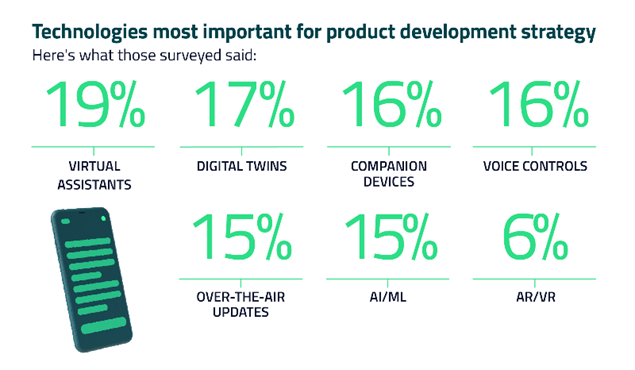Study reveals: factory connectivity rises, tech priorities vary in Industrial Automation
September 20, 2023 by Patrick Dalez | Comments
Industrial Automation manufacturers are divided on technology investments that will deliver competitive advantages. Even as technological evolution surges forward, the sector grapples with macroeconomic challenges.
Despite investing in wide-ranging technologies, manufacturers in industrial automation are still searching for silver bullet innovations that will deliver competitive advantages, as revealed by our new study.
When asked which factors have affected product development the most, 39% of respondents cite connectivity, 32% say interoperability and 30% claim AI/ML.
While factories and processing plants have gradually adopted more automation tech to improve production efficiency and quality, these are old-school now. Historically, the sector has hesitated to initiate major changes that take a long time to permeate the industry. That might explain the scattered focus on technologies. We do, however, expect that as AI proliferates in other sectors, industrial automation will follow suit to prioritize it more.
In our conversations with industrial automation stakeholders, technologies related to things like over-the-air updates and connectivity are still extremely divisive. For many factories, the machines they build or procure are huge upfront investments, and they need to run for decades. As part of the industry evolution, however, more and more manufacturing environments add components to SCADA (Supervisory Control and Data Acquisition) with companion apps and devices, focusing on visualizing data from headless devices and remote sites. The monitoring and interaction between factory machines and devices, and their digital twin counterparts, has significantly impacted the demands for connectivity.

According to the survey, respondents' technology preferences for product development vary. Interestingly, AR/VR trails significantly behind (6%), tracking with market news of a significant slowdown in global 2023 shipments of AR/VR headsets compared to pandemic-driven highs. The effect of tech trends on industrial automation is relatively low compared to the significant influence trends have on other industries like automotive, as revealed by previous Qt research.
Respondents also say that enhancing their devices’ UI and UX is a key priority. The primary drivers include financial gains (29%), advancement in technology capabilities (29%), increasing market share (27%), and innovation from competitors (19%).
However, there are signs of some OEMs struggling to keep up with improving device UI/UX. About 35% of respondents say they will spend at least half their budget on improving UI/UX in embedded devices in the next year - down from 38% who spent the same amount in the last 12 months.
Macroeconomic conditions have also taken their toll on manufacturers: not a single OEM reports their product development being unaffected by the economy. The biggest impacts respondents cite include increased product prices (47%), lower profit margins (47%), and increased time-to-market (41%). In response, over 40% say they are adopting cross-platform development tools and acquiring new talent, while 36% are extending deadlines for delivery, and 37% are streamlining product lines and rewriting software
Macroeconomic headwinds are reshaping how organisations approach product development. Industrial automation OEMs know they have to innovate on their devices’ UI/UX, but that’s hard to do when many companies have so few UI/UX developers. Sometimes, they don’t even have designers and are asked to build and deliver ‘Apple-style’ interfaces with limited time and resources. The right software development framework can go a long way towards mitigating this resource challenge.
The full report can be downloaded here.
Note to the editors
Research conducted by Censuswide, on behalf of Qt Group, in December 2022. 250 embedded device manufacturers in automotive, healthcare, consumer electronics, and industrial automation were surveyed across the UK, the U.S., France, and Germany. The study was nationally representative.
Blog Topics:
Comments
Subscribe to our newsletter
Subscribe Newsletter
Try Qt 6.10 Now!
Download the latest release here: www.qt.io/download.
Qt 6.10 is now available, with new features and improvements for application developers and device creators.
We're Hiring
Check out all our open positions here and follow us on Instagram to see what it's like to be #QtPeople.


